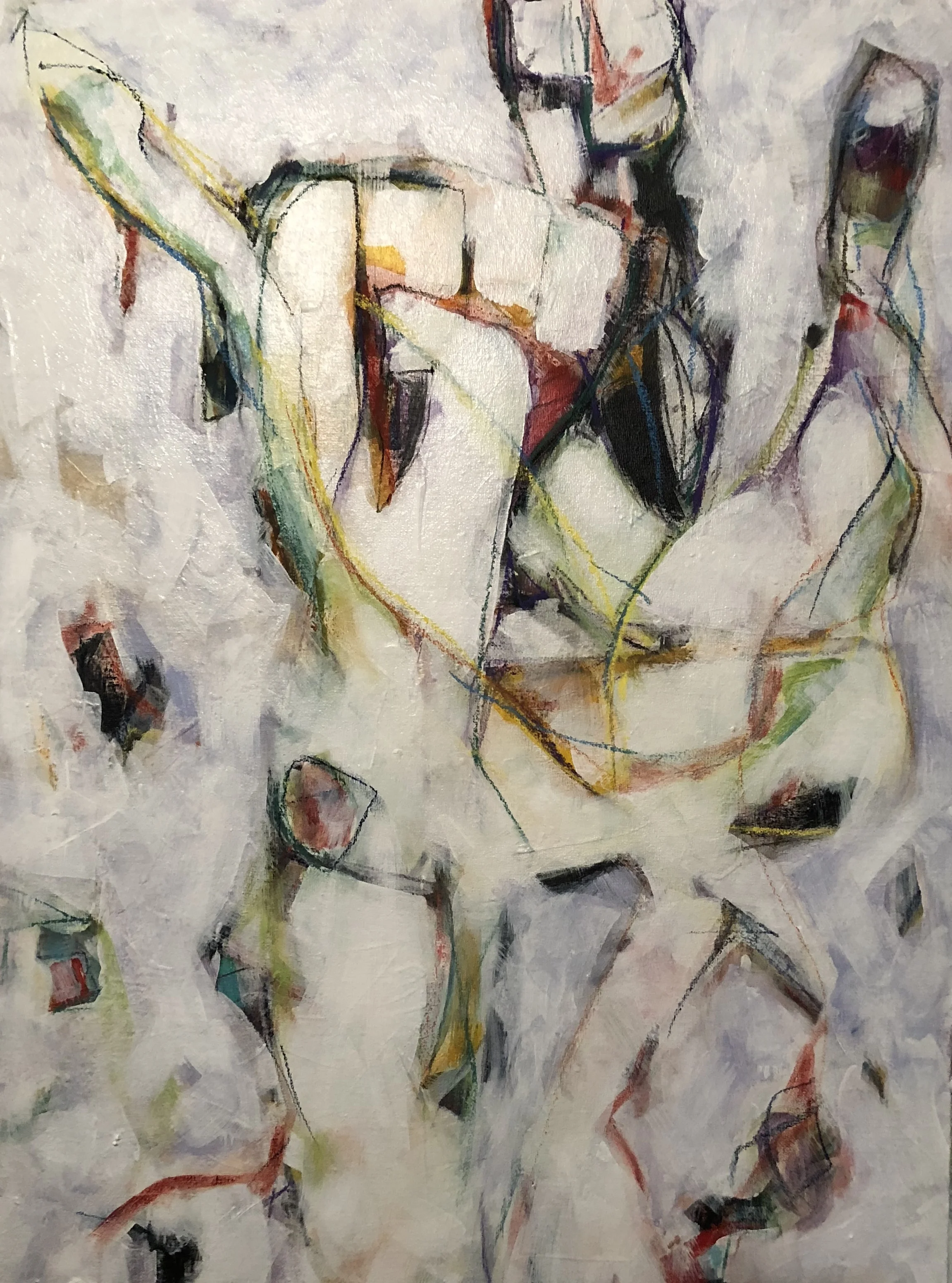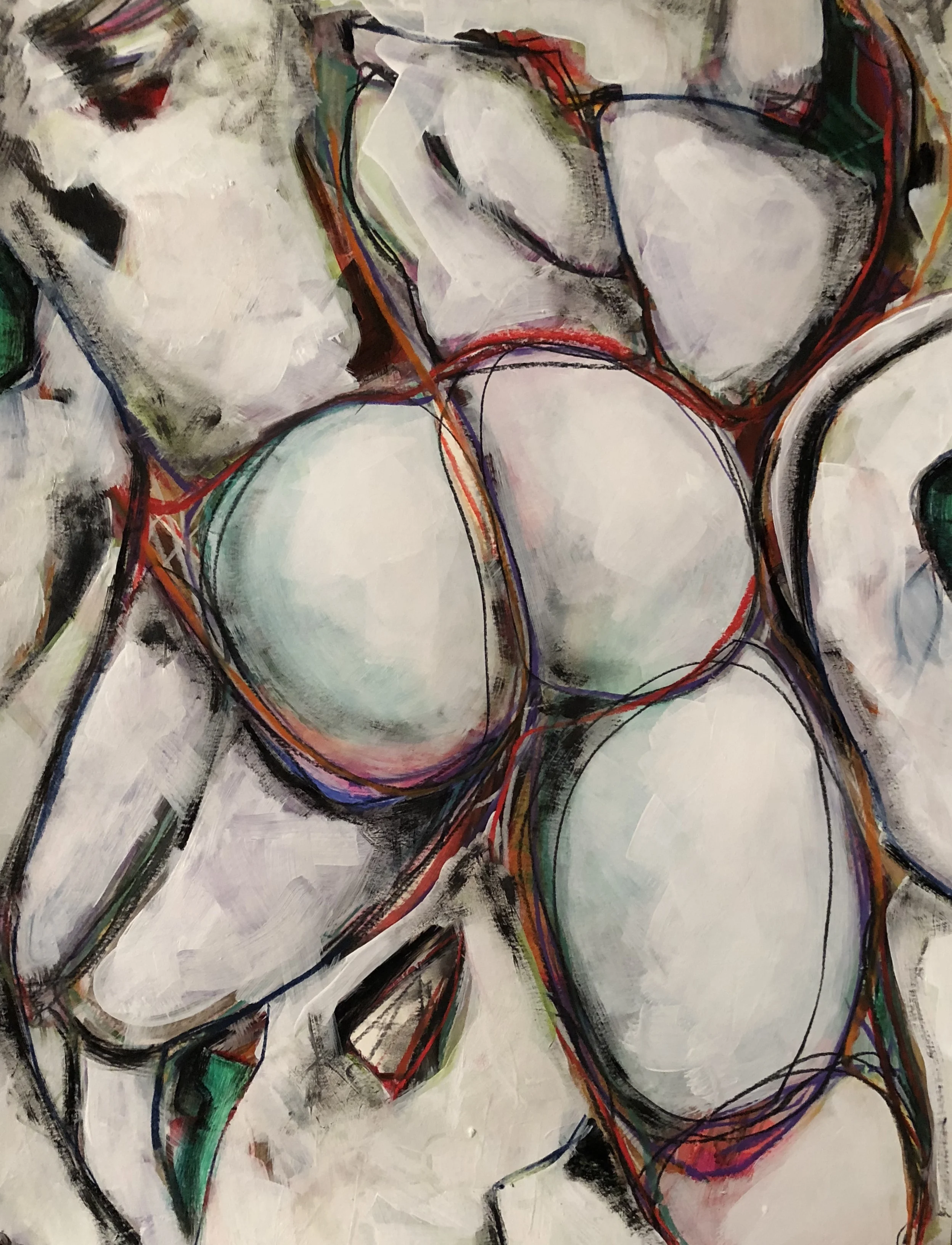2018
Isaiah (12:18)
Mixed media (December 2018)
Familiar model — unfamiliar territory.
In this third model-specific series, initially I felt excited because I was sketching over old pre-painted canvases so that the beginning underpainting was a rich visual source and the model (Isaiah) was a comfortable and familiar friend. But as I worked on these, the “space between” became crowded and complex.
In painting 1 a crowd of bursting bubble heads. In painting 2 a chorus of absurd beings. In painting 3 a desperate embrace under attack. In painting 4 demons confront a meditating figure. In painting 5 two figures are locked in physical struggle. And in painting 6 up to six figures witness some “pagan” ritual.
These painting feel narrative although the only way to bring the story to consciousness has been to paint them. Looking at them now I’m unclear whether I’m imposing a story or seeing something that’s really there.
And what this has to do with the model? Well, it isn’t conscious.
I’m tempted to say that with Isaiah I felt free to bring in more that just the experience of viewing him — and that the politics of our time filtered into the space between. I have been troubled by the inability to discern the truth. I see something that, to me, seems clear and factual, and yet the next moment “spin” takes over. Actions, statements, tangible facts no longer have meaning. I’m not naive. The truth is rarely simple, but I know what I see — and that’s coming from someone who looks into the “space between.”
PHIL (10:18)
Mixed media (October 2018)
Reluctant model.
In this second model-specific series, I struggled with underlying sketches that were, on the surface, generic and simple. Phil, the model for these six pieces, was shy. I think the novelty of modeling hadn’t caught up with the reality of it until he was there and I was looking at him. I didn’t want to push. I wanted to work with what he was offering — simple and direct.
Instead of casting the sketches aside I decided to see what story they were telling me.
The challenge became filling the space — to stretch way beyond what was on the page. I had to look straight at the nervousness, uncomfortableness, reluctance, and confusion all around — and see if I could paint those qualities. I needed to infuse the space between the object and the viewer with those qualities.
I embraced the figure as the starting point only and quickly broke free of the lines and shapes of the figure on the page and searched the space around it for meaning, feeling tone, even for the final figure’s location in space. By letting go I was able to find more. I felt I stretched the scope of what I do and added new marks to my “alphabet.” The personification of the feelings overwhelmed the original figure — and that feels right.
Matisse’s “Cut Outs” were a source of inspiration for this series as I searched for how to give life to the negative space around the original figure and still hold on to a sense of place.
MICHAEL (9:18)
Mixed media (September 2018)
Solids and fluids.
Underlying the alphabet I’m developing is the inspiration. Since I start with a figure sketch the model is the inspiration. The model acts as a still life or the landscape would — the foundation on which my point of view is layered.
Michael is solid. A bit of an anatomy lesson. It was difficult to see beyond his structural elements. But as he posed, he constantly shifted — his body, his attention, his story, his emotions — and that was captivating as well. He was newly in love. His lover was in the studio with us (not physically — but every other way possible). Once I accepted his presence the painting started to make sense. Someone there but not which fits so well into my emerging and submerging process and my visualizing the space between concept.
Michael was a good model for me.
While working on these paintings I rediscovered the work of Susan Rothenberg. I knew of her horse paintings (powerful muscled beings reinterpreted with paint), but I was also interested in where her work has evolved.
ALPHABET: PART TWO (6:18)
Mixed media (June 2018)
This alphabet series is a further dive into the elements of the first alphabet series. It is still an exploration, but the materials (except for a limited use of ink) and process have become consistent — a model pastel/charcoal sketching session then the addition of acrylic paint, more drawing as related spaces begin to emerge, then the “white out” phase, then redrawing the figure(s) in this new environment, more color, more white, more line, submerging and emerging as the space between the initial image/object and the viewer/painter becomes more active with memory and the emotion of letting go of favorite parts and struggling to find the correct balance.
The alphabet is starting to form words. My visual vocabulary is taking shape. A few more experiments with materials (particularly which ground — canvas, paper, board) and I might be ready to tell a story.
ALPHABET (4:18)
Mixed media (April 2018)
The work this month appears more cohesive though many questions still remain. On a philosophical level I am asking big questions like: what is my intention, am I painting what I see, am I painting what I imagine. The initial drawings are from live models. The painting is done when I’m alone at the studio. The figures submerge and then emerge over and over as different areas draw my interest.
In the meantime the materials and methods are becoming more consistent. The objective is still to “see” the space between while developing a visual vocabulary. I’m seeing some of the letters that I will need before I can start “writing” words.
An example of the artistic process I found is a video by Julie Schumer. If you like watching paint dry this gives her version of what goes into creating a visual story.
PERCEPTION (3:18)
Mixed media (January - March 2018)
Picasso and Giacometti are two portraitists I have always been drawn to. Their visual philosophical and existential exploration of the human form makes sense to me: Picasso's intellectual embrace of cohabiting perspectives (cubism); Giacometti's scribbling search for essential form. Painting a portrait that looks like the person doesn't feel as honest or as important as painting what I sense. Part of my experience of seeing is my perception of the person/object. That perception is influenced by more than muscles, features, and skin tone. I paint the object and everything about the object. I paint everything that exists between me and the object be that history, attraction, environment, confusion, brightness, temperature, mood, gesture...the list is endless.
A fun video to watch on Picasso's process.
A fun video to watch on Giacometti's process.








































